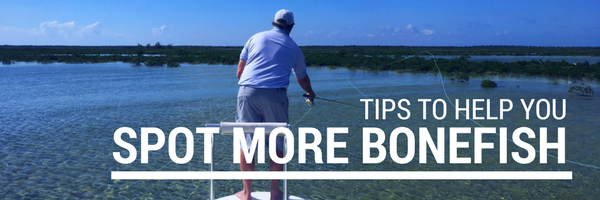Spotting bonefish is about far more than simply identifying their location. You also need the ability to determine their behavior and their most likely course of action. To make things all the more complex, these fish have near-perfect camouflage and they’re constantly on the move. Although it’s good to rely on the advice and directives of your guide, it’s important to develop bonefish spotting skills of your own. The following tips will help you get started.
Check For Movement
While most newbies start by scanning the water for the clear outline of a bonefish, this isn’t something that you’re likely to stumble across. The sides of these fish are bright and reflective, not unlike mirrors. Thus, if they’re swimming along a dark flat bottom, these fish will look equally dark, and if they happen to be swimming over pale rocks, they’ll blend right in. When you do spot a bonefish, what you’ll likely see is a slow-moving, dark spot or shadow.
Rather than casting straight off at one of these spots, spend a few minutes to assess the movement of the water and to find a stationary object on the flat bottom. This will serve as an excellent reference point for determining whether or not your dark spot is actually going somewhere and whether it’s actually a bonefish. Given that bonefish typically feed in shallow waters, their movements while feeding usually create noticeable disturbances at the surface. Tails, nervous water and ripples are all obvious signs of underwater activity that merit further interest, even if you can’t clearly see the outline or shadow of your target.
Follow The Bonefish You’ve Just Released
Releasing a bonefish gives you one of the best opportunities to see how these fish look at different distances. When you or someone else on the boat releases one, be still and pay careful attention. By following the bone’s movement for as long as possible, you will improve your ability to identify these fish from far away.
Spot Other Species
Take note of other species in the area. There are lots of silver-sided creatures like shad and barracuda that can give you a better understanding of how a bonefish might appear in the area that you’re fishing. Given that bonefish look different according to the appearance of the flat bottom, assessing how other species reflect the colors of the flat can be incredibly helpful.
Be On The Lookout For Birds
Bonefish are not fond of birds. Having the shadow of a bird pass over the surface of the water will spook these fish and put them on the move. While this can be a very frustrating and unexpected event, especially if it happens right before you cast, it is also something that can definitely work to your benefit. Whenever birds fly over, check further out from your normal gazing distance. The rapid and panicked activity of a school of bonefish two hundred yards away will help you dramatically increase your spotting distance. When just starting out, most bone fishers can spot fish up to just 40 or 50 feet away, while their guides can spot fish as far as 80 feet away or further. Being mindful of how events outside of the water can make an entire school of bonefish react will give you far more insight into what’s going on at great distances.
Be Still
Being still is essential for a number of reasons. Your footfalls on the boat bottom could wind up spooking nearby fish off. Being still also limits the likelihood of you accidentally dragging or dropping equipment and making other loud, conspicuous noises. More importantly, however, your willingness to simply stay put and let your eyes do the work will allow you to spot fish right under your nose that would have otherwise been missed. Spend the majority of your time looking across the areas in which you can clearly see underwater activity. Then check to your sides by using your peripheral vision and by slowly turning your head. Keep in mind that bonefish act and move a lot like kids. They rarely stay still and they’re constantly milling about, turning and changing direction. This means that a big bonefish could be right nearby. Staying still and keeping your focus will always be the best way to spot it.









